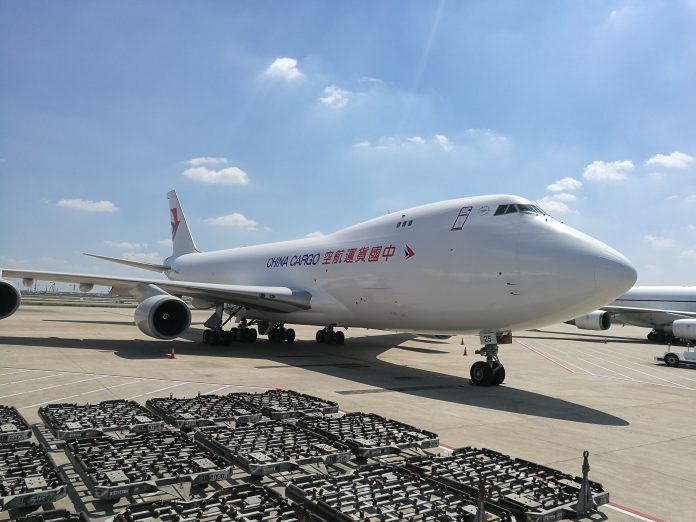 The International Air Transport Association (IATA) released data for September 2025 global air cargo markets showing: Total demand, measured in cargo tonne-kilometres (CTK), rose by 2.9% compared to September 2024 levels (+3.2% for international operations); Capacity, measured in available cargo tonne-kilometres (ACTK), increased by 3.0% compared to September 2024 (+4.4% for international operations).
The International Air Transport Association (IATA) released data for September 2025 global air cargo markets showing: Total demand, measured in cargo tonne-kilometres (CTK), rose by 2.9% compared to September 2024 levels (+3.2% for international operations); Capacity, measured in available cargo tonne-kilometres (ACTK), increased by 3.0% compared to September 2024 (+4.4% for international operations).

“Air cargo demand grew 2.9% year-on-year in September, marking the seventh consecutive month of overall growth. Buried in that growth is a significant alteration of trade patterns as US tariff policies, including the ending of de minimis exemptions, kick in. On one side of the equation, a decline in North America-Asia demand has set in over the last five months. But this has been more than compensated for with strong growth within Asia and on routes linking Asia to Europe, Africa and the Middle East. While many had feared an unwinding of global trade, we are instead seeing air cargo adapting successfully to serve shifting market demands,” said Willie Walsh, IATA’s Director General.
Several factors in the operating environment should be noted:
- The global goods trade grew by 3.7% year-on-year in August.
- Jet fuel prices rose 5.4% in September despite lower oil prices, driven by a tighter diesel market, which doubled the crack spread year-on-year.
- Global manufacturing sentiment strengthened in September, with the PMI rising for the second straight month to reach 51.3. New export orders improved slightly to 49.6 but remained below the 50-point expansion threshold, reflecting ongoing caution amid tariff uncertainty.
|
Air cargo market in detail – September 2025 |
||||||
| World share, %1 |
September 2025 (year-on-year, %) | |||||
| CTK | ACTK | CLF (%-pt) | CLF (level) | |||
| TOTAL MARKET | 100.0 | 2.9 | 3.0 | 0.0 | 45.7 | |
| Africa | 2.0 | 14.7 | 7.4 | 2.8 | 44.4 | |
| Asia Pacific | 34.3 | 6.8 | 4.8 | 0.9 | 49.3 | |
| Europe | 21.5 | 2.5 | 4.4 | -0.9 | 51.3 | |
| Latin America
and Caribbean |
2.9 | -2.2 | 3.1 | -1.9 | 35.2 | |
| Middle East | 13.6 | 0.6 | 5.5 | -2.2 | 45.4 | |
| North America | 25.7 | -1.2 | -1.5 | 0.1 | 39.4 | |
| 1 % of industry CTK in 2024 | ||||||
September Regional Performance
- Asia-Pacific airlines saw a 6.8% year-on-year growth in air cargo demand in September. Capacity increased by 4.8% year-on-year.
- North American carriers saw a 1.2% year-on-year decrease in growth for air cargo in September. Capacity decreased by 1.5% year-on-year.
- European carriers saw a 2.5% year-on-year increase in demand for air cargo in September. Capacity increased 4.4% year-on-year.
- Middle Eastern carriers saw a 0.6% year-on-year increase in demand for air cargo in September. Capacity increased by 5.5% year-on-year.
- Latin American carriers saw a 2.2% year-on-year decrease in demand for air cargo in September, the slowest growth of all regions. Capacity increased by 3.1% year-on-year.
- African airlines saw a 14.7% year-on-year increase in demand for air cargo in September, the strongest rise of all regions. Capacity increased by 7.4% year-on-year.
Trade Lane Growth
Air freight volumes in September 2025 increased across most major trade corridors. Europe–Asia and Within Asia posted robust double-digit growth, while Middle East–Asia, North America-Europe, and Africa-Asia also saw notable gains. In contrast, Asia–North America, Middle East–Europe and Within Europe recorded declines.
| Trade Lane | YOY Growth | Notes | Market Share of Industry |
| Asia-North America | -3.5% | 5 consecutive months of decline | 24.40% |
| Europe-Asia
|
+12.4% | 31 consecutive months of growth | 20.50% |
| Middle East-Europe
|
-4.6% | 2 consecutive months of decline | 5.70% |
| Middle East-Asia
|
+4.6% | 7 months consecutive months of growth | 7.40% |
| Within Asia
|
+10.0% | 23 consecutive months of growth | 7.00% |
| Within Europe | -1.1% | 2 consecutive months of decline | 2.00% |
| North America- Europe | +2.6% | 20 consecutive months of growth | 13.3% |
| Africa-Asia | +9.6% | 3 consecutive months of growth | 1.40% |
*Share is based on full-year 2024 CTKs.
IATA updates cargo and ground operations manuals
The International Air Transport Association (IATA) has released the updated 2026 editions of key industry manuals for cargo and ground operations, which incorporate close to 100 major changes and revisions to align with evolving global standards. The main changes to the 2026 manuals include:
Dangerous Goods Regulations (DGR) and Battery Shipping Regulations (BSR)
Battery-related updates dominate the DGR and BSR for 2026. The number of lithium batteries transported as cargo by air have surged 25% year-on-year1. At the same time, the industry has seen several incidents involving overheating power banks on aircraft, contributing to the need for revised regulations around the shipment of lithium batteries. The past year has also seen the emergence of new hybrid battery chemistries—particularly those used in hybrid vehicles—requiring updated shipping requirements. The key changes to the 2026 DGR include:
- The introduction of formalised shipping names for hybrid-powered vehicles;
- Recommendations on the use of power banks and spare batteries by passengers in the cabin;
- Updated variations for Thailand, France and United Kingdom;
- Standardised text for 290 existing operator variations;
- Additional guidance regarding safety data sheets required for certain dangerous goods;
- The inclusion of Appendix H, which sets out a number of changes expected in 2027.
The key changes to the 2026 BSR include:
- Stricter charge limits for lithium-ion batteries packed with equipment;
- New shipper compliance checklist for battery shipments;
- Additional Designated Postal Operators that may accept equipment containing lithium batteries.
Live Animals Regulations (LAR)
IATA’s LAR has been significantly updated to further improve animal welfare. IATA data shows that more than 200,000 non-domestic animal shipments were made in 20241, highlighting a need to maintain high standards of care. There have been major changes to container requirements and guidance on training for attendants handling animals during transit.
The key changes include:
- Guidelines for attendants on providing appropriate and safe care during transit, including standardised Competency-Based Training Assessment recommendations;
- Inclusion of Brazil, which in 2025 officially adopted the LAR;
- New material and ventilation specifications for animal containers;
- Updated guidelines for poultry, pangolins, hooded raptors and birds of prey.
IATA Ground Operations Manual (IGOM)
The 2026 IGOM focuses on improvements to operational efficiency and safety across passenger, baggage, and aircraft handling operations, with a particular focus on passengers that require special support.
The key changes include:
- New guidelines for unaccompanied minors, unruly passengers, inadmissible passengers and those needing medical assistance;
- Baggage tracking guidelines aligned with IATA Resolution 753;
- Updated procedures to address preparation, collection and transportation of potable water;
- Revised aircraft turnaround procedures.
Digital Tools
Several new digital enhancements to the manuals make it easier for cargo professionals to quickly access information. These include:
- Launch of IATA’s online portal LAR Verify, enabling airlines, shippers and freight forwarders to digitally access the LAR while providing an automated compliance solution;
- A comprehensive list of dangerous goods in digital format;
- An improved battery classification tool which now includes sodium-ion batteries.
“Global standards have made flying safe and reliable. For eight decades, IATA’s member airlines have worked with the industry value chain, including regulators, on standard setting and best practices critical to daily operations. This year’s IATA manuals updates reflect advancements in technology, digitalisation, regulation, and customer needs that are critical for safer, more efficient, and increasingly sustainable operations,” said Frederic Leger, IATA’s Senior Vice President of Products and Services.



















